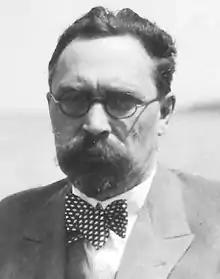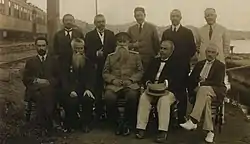Leonid Ustrugov
Leonid Aleksandrovich Ustrugov (Russian: Леонид Александрович Устругов; November 23, 1877, Moscow – February 15, 1938, Moscow) was a Russian railway engineer. Minister of Railways in the government of Admiral Alexander Kolchak (1918–1920).
Leonid Aleksandrovich Ustrugov | |
|---|---|
Леонид Александрович Устругов | |
 | |
| 1st Minister of Transport of the Russian Government | |
| In office November 18, 1918 – November 13, 1919 | |
| Prime Minister | Alexander Kolchak |
| Preceded by | Office established |
| Succeeded by | Alexey Larionov |
| Personal details | |
| Born | November 23, 1877 Moscow, Russian Empire |
| Died | February 15, 1938 (aged 60) Kommunarka shooting ground, Moscow Oblast, Soviet Union |
| Resting place | Kommunarka shooting ground |
| Education | Institute of Railway Engineers |
| Awards | Order of Saint Anna |

Family
His parents are unknown. In 1891, he was given the surname of the daughter of major Vera Gavrilovna Ustrugova, who adopted him.
- First wife – Elizabeth Stepanovna. Daughters – Vera Leonidovna, Tatyana Leonidovna, Elena Leonidovna.
- Second wife – Maria Ivanovna. Sons – Leonid Leonidovich, Nikolai Leonidovich (died in the first winter of the siege of Leningrad).
Education
He graduated from the Komissarovsky Technical School (1897) and the Saint Petersburg Institute of Railway Engineers (1902) with the title of engineer of communications and the rank of collegiate secretary.
Railway Engineer
- 1902–1906 – the manufacturer of the construction of the Moscow Ring Railway.
- From April 1, 1906 – Assistant Chief of the section of the Moscow–Kiev–Voronezh Railway.
- From June 23, 1906 – controller of passenger trains at the Moscow–Passenger station.
- From September 16, 1906 – a reserve agent for the Moscow–Passenger station.
- From February 1, 1907 – Assistant Head of the Northern Railway's technical movement.
- From January 1, 1909 – Auditor, from July 15, 1909 – Senior Auditor of the Northern Railway Traffic Services.
- From January 8, 1911 – Assistant Chief of the Service of the Samara–Zlatoust Railway.
- From April 15, 1913 – Head of the Omsk Railway Traffic Service, Deputy Head of the Omsk Railway. For impeccable mobilization work in 1914 he was awarded the Order of Saint Anna, 3rd class.
- From May 1, 1916 – Head of the Omsk Railway.
- From November 1, 1916 – Assistant Head of the Railway Department of the Ministry of Railways of Russia.
- From February to October 1917 – Deputy Minister of Railways under the Provisional Government.[1]
Activities during the Civil War
Participated in the Russian Civil War. On the night of January 25–26, 1918, at a secret meeting of the Siberian Regional Duma, he was elected in absentia and without his consent by the Minister of Railways in the center-left anti-Bolshevik government of Peter Derber. In April 1918, at a meeting of shareholders of the Chinese Eastern Railway (CER), he was elected a member of the provisional board of the CER, was a member of the so-called "Business Cabinet" headed by General Dmitry Horvat as Minister of Communications.[2]
From November 4, 1918 – Minister of Railways of the Provisional All-Russian Government, from November 18, 1918 – Russian Government, acting under the Supreme Governor Alexander Kolchak. Since November 19, 1918, at the same time, Deputy Chairman of the Council of Ministers. He was considered one of the most competent members of the government of Alexander Kolchak, he had little interest in political issues. In March 1919, in Vladivostok, he signed an agreement on the management of the Trans-Siberian Railway with allies from the International Committee, which was supposed to improve throughput, increase and streamline the freight traffic of this railway. However, according to historians, a dual power arose between Ustrugov and the American engineer Stevens, which had a negative effect on the work of the highway.[2]
In the autumn of 1919, he acted as head of military communications of the rear as an assistant chief of staff of the Supreme Commander-in-Chief (the ministry was headed by Deputy Minister of Railways Minister Alexei Larionov).[1]
Emigration, return, death
In 1920 he emigrated to China. He and his family lived in Harbin, in 1924–1935 he was the second rector of the Harbin Polytechnic Institute, where Russian emigrants received engineering education.
In 1935, at the invitation of the government, he and his family returned to the Soviet Union together with the employees of the CER – the Soviet citizens. For some time he worked in the specialty of the People's Commissariat of Communications in Moscow.[3]
On October 7, 1937, he was arrested. On February 15, 1938, he was sentenced by the Military Collegium of the Supreme Court of the USSR to be shot on charges of espionage and participation in a counter-revolutionary organization. On the same day, he was shot and buried at the Kommunarka shooting ground (the former dacha of Genrikh Yagoda on the Kaluga highway not far from Domodedovo airport south of Moscow). He was rehabilitated in May 1989 by the Plenum of the Supreme Court of the USSR.[4]
Sources
- Nikolai Dmitriev. Ministers-railwaymen // White army. White matter. Historical popular science almanac. Number 10. Ekaterinburg, 2002.
References
- Ustrugov Leonid Aleksandrovich
- Vladimir Shishkin. On the history of the coup in Omsk (November 18–19, 1918)
- Regional newspapers
- Victims of political terror in the USSR
External links
- Biography on hrono.ru
- Vladimir Shishkin. On the history of the coup in Omsk (November 18–19, 1918)
- List of victims of political terror in the USSR on the Memorial Society website.